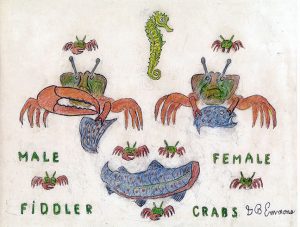Crabs are classified as crustaceans and are highly valued as predators and scavengers to the Buzzards Bay ecosystem by keeping it clean and also providing a valuable food source for the environment and humans.
Many miles of the Buzzards Bay shoreline here are perfect for fiddler crabs, which have a ‘clock’ in their heads to be in tune with the rhythm of the tides, preferring a muddy mangrove habitat with rich organic matter but also right at home in the breaking of waves.
Fiddlers are omnivorous, meaning they will eat almost anything, including carrion of the dead or dying, especially fish commonly used for bait to catch them in nets or traps.
Their protective hard shells are like a knight’s suit of armor but do not grow with their body, requiring the crabs to annually molt and shed their shells for a larger size, as many as fourteen times in a lifetime.
The male fiddler has an oversize claw used as a warning to trespassers and competitors for female attention. The female has two small claws. After mating, she gives birth to millions of eggs called larvae that when fertilized look like jelly that bears no resemblance to adults until about five weeks when metamorphosis turns them into tiny crabs.
Research suggests that fiddlers communicate by drumming their claws on the ground or by snapping them together, and they can detect the slightest movement around them. They have a keen sense of hearing through multiple hairs on the body. Each hair is also sensitive to chemical changes to help them to locate food.
When threatened, they often freeze to resemble a rock or promptly bury themselves in the mud. They have powerful vision to see movement all around without turning their heads using two compound eyes that have hundreds of tiny cells on the tips of eye stalks that protrude from their heads and can fold into protective grooves.
Fossils show that crabs have been around for some 120 million years, able to protect themselves with their feisty demeanor while also lending themselves to a variety of shapes and colors for vibrant art recently featured on Australian stamps for The World Wildlife Fund.
For children, a crab too clever to be caught called Sebastian appeared in the Walt Disney animated film The Little Mermaid, but don’t let your child pick one up to find out they are very feisty.
By George B. Emmons
